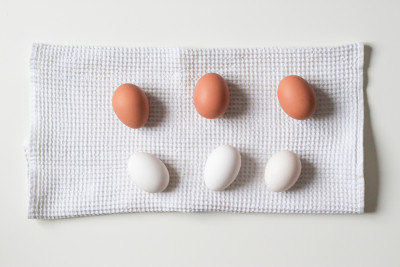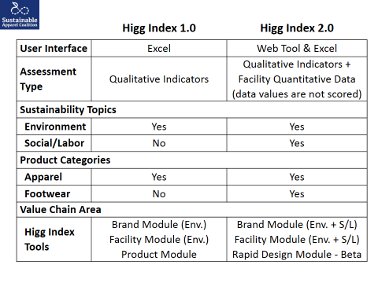 The Higg Index is an apparel and footwear industry self-assessment standard for assessing environmental and social sustainability throughout the supply chain.
The Higg Index is an apparel and footwear industry self-assessment standard for assessing environmental and social sustainability throughout the supply chain.
The Higg Index 1.0 was released on June 26, 2012.
Past Development, Scope
The first version of the Higg Index was an adaption/integration of three previously existing sustainability measurement standards: the Nike Apparel Environmental Design Tool; the Eco Index (lead by the European Outdoor Group); and Global Social Compliance Program (GSCP)‘s Environmental Facilities Assessment.
Sustainable Apparel Coalition Training Video: Higg Index 1.0 Training – Product.The Higg Index 1.0 measures assessed a products footprint from cradle to gate (only):
– 3 factors where thereby considered in full depth: water, energy / CO2, and waste.
– 3 further factors were measured to a lesser extent: chemicals, biodiversity, and land use.
– version 1.0: any type of social assessment criteria were still excluded as of yet, although this has changed for version 2.0.
The Higg Index assessment triangulate a products impact from three different angles, each corresponding to an assessment tool:
– Facility assessment tool
– Brand assessment tool
– and the Product assessment tool.
In Version 1.0 the KPIs were by and large of qualitative type, and were provided as Excel sheets (open source).
Status Quo: Higg Index 2.0

The Higg Index 2.0 was released on December 11, 2013 and represents a significant step forward, not the least because of a significant update in its material database (Material Sustainability Index MSI), and the inclusion of also social/labour assessment criteria.
As can be seen in the comparison of V1 to V2 (right), the index further now incorporates a range of quantitative assessments, measures for footwear specifically, and a first version of a tool in support of designers.
While both the Facility as well as the Brand module have been updated, the short comings of the Product module were so significant (in accordance to feedback to the V1.0 release), that the release of its updated 2.0 version has been postponed until further notice.
Beyond the present: Ongoing and future developments
In the up run to the version 2.0 launch further developments got underway: In March 2013, a group of leading home textile retailers such as Target, Yunus Textile Mills (Pakistan), Williams-Sonoma or Coyuchi joined forces and launched a new initiative called ‘The Sustainable Textiles Coalition’. This initiative is, by all means and intends, the textile equivalent to the Sustainable Apparel Coalition. A close collaboration is expected in order to develop an environmental index for the home and interior textiles sectors – which likely and ultimately may mean an extension of the Higg Index to encompass assessments of home and interior textiles also.
Further close/r collaborations can be expected with ZDHC (Roadmap to Zero) for chemicals, and the Leather Working Group for the leather and hide supply chain (of specific relevance for accessories and footwear).
Finally, efforts are underway – unofficially supported by the Sustainable Apparel Coalition – to create a professional services company that supports the Higg Index and the SAC’s Members. The venture has been named ‘Indicate Advisory‘ and is headed by Ryan Young, former SAC Vice-Director.
And while there is no official statement of any type at this stage, there is a certain likelihood that on the long-run, there may be a consumer faced label associated with the Higg Index, which would allow Higg Index implementing brands to include product scores into their marketing efforts.
Conclusion
The Higg Index as in barely 2 years become the most widely recognised approach of the wider textile industry for a structured, measurable and pragmatic way to assess, and then reduce the industry’s environmental and social footprint.
Development which are underway point towards a progressive quantification of the approach on the one hand, but also that there is considerable insider knowledge around that is about to be exploited commercially.
The index is further in the process to find a much larger audience than very originally intended. Be it in home and interior textiles, in outdoor and performance wear, or in leather, luxury and accessory goods.
The Higg Index biggest draw back is the fact that its development and maintenance is down to a coalition of brands, and hence is largely based on consensus. And while this aspect may be considered the index Achilles’s heel, it is at the same time its strongest point: After all, the outcome of such consensus searching is a tool that finds broad acceptance in an industry that is otherwise cherishing and proud of its variety and differences.

